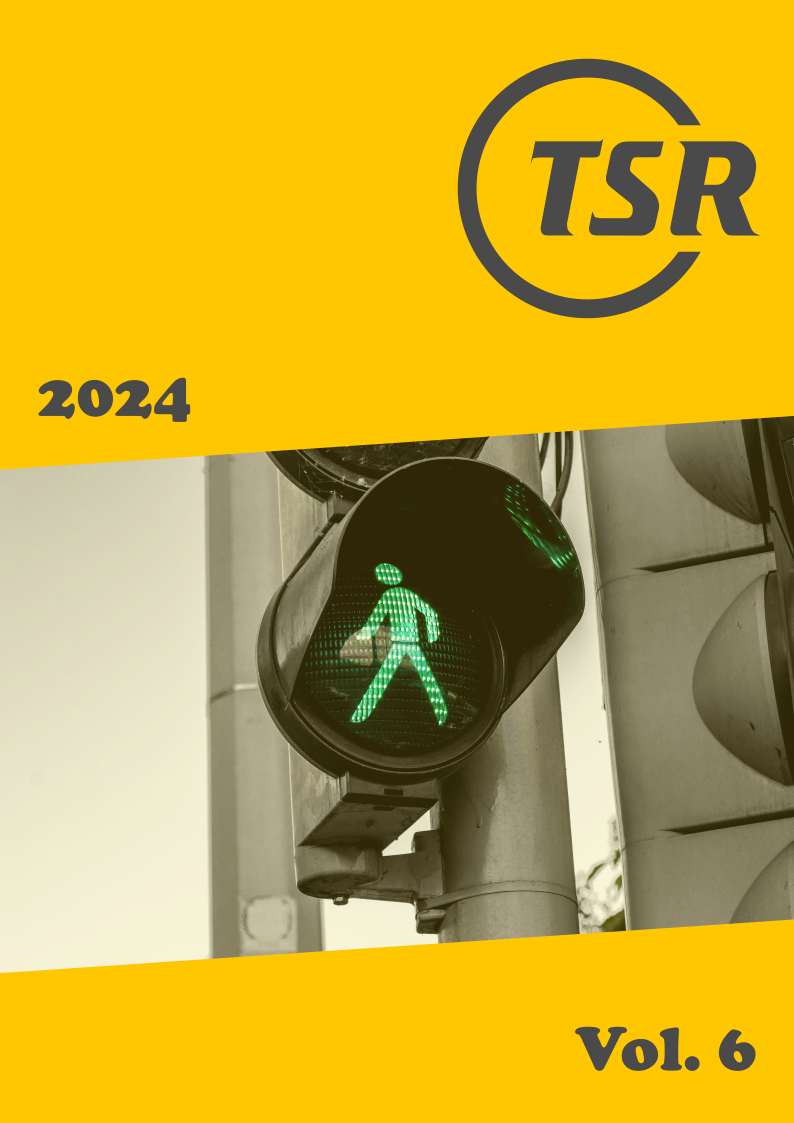Investigating factors that affect conflicts between bicyclists and right turning vehicles at signalized intersections
DOI:
https://doi.org/10.55329/pytz4050Keywords:
bicyclists, cross-sectional regression models, intersection safety, right hook conflicts, safety countermeasures, surrogate measures of safetyAbstract
Due to the recognition of active transportation as a beneficial alternative to more traditional modes of transportation, there is increasing interest in designing infrastructure systems to promote the safe use of forms such as bicycling. Collision data, which are typically used in road safety studies, may be incomplete and the use of such data is reactive as it requires collisions to have already taken place. Additionally, collisions involving bicyclists and vehicles are less common than those between vehicles. As a result, alternative approaches for evaluating the safety effect of various infrastructure attributes, such as the use of surrogate safety measures, specifically traffic conflicts, could be considered. Most collisions between bicyclists and vehicles occur at intersections and of these, collisions between right turning vehicles and bicyclists form the majority. The main objective of this study was to use cross-sectional regression models to investigate various intersection characteristics, including geometry, signal phasing, and bicycle infrastructure, with a view to determining which attributes are associated with a significant effect on right turning conflicts and how this may vary with different conflict severity levels. Using data for 65 signalized intersection approaches across Canada, various intersection attributes were found to be associated with the frequency of right turning conflicts such as exposure levels, the lateral offset of the bicycle facility and the grade of the approach to the intersection. The significance levels of the associated effects of certain attributes were observed to change with the severity level of the conflicts.
Downloads
References
Anarkooli, A. J., B. Persaud, C. Milligan, J. Penner, T. Saleem (2021), 'Incorporating speed in a traffic conflict severity index to estimate left turn opposed crashes at signalized intersections', Transportation Research Record, 2675(5), 214–225. DOI: https://doi.org/10.1177/0361198120986167
Bassil, K., H. Rilkoff, M. Belmont, A. Banaszewska, M. Campbell (2015), 'Pedestrian and cyclist safety in Toronto', Toronto Public Health, 416.338.7600.
Buch, T. S., S. U. Jensen (2017), 'Incidents between Straight-ahead Cyclists and right-turning motor vehicles at signalised junctions', Accident Analysis & Prevention, 105, 44–51. DOI: https://doi.org/10.1016/j.aap.2016.07.035
Chen, P., W. Zeng, G. Yu, Y. Wang (2017), 'Surrogate safety analysis of åedestrian-vehicle conflict at intersections using unmanned aerial vehicle videos', Journal of Advanced Transportation, 2017. DOI: https://doi.org/10.1155/2017/5202150
City of Toronto, (2022), 'Vision Zero plan overview', City of Toronto.
De Ceunynck, T. (2017), 'Defining and applying surrogate safety measures and behavioural indicators through site-based observations', PhD thesis, Lund University, Sweden | Hasselt University, Belgium.
Government of Canada, (2022), 'Active transportation', Active Transportation.
Gross, F., C. Lyon, B. Persaud, J. Gluck, M. Lorenz, S. Himes (2018), 'Safety evaluation of access management policies and techniques', Federal Highway Administration, FHWA-HRT-14-057.
Hauer, E. (2015), The Art of Regression Modeling in Road Safety, (New York, US: Springer). DOI: https://doi.org/10.1007/978-3-319-12529-9
Hauer, E., J. Bamfo (1997), 'Two tools for finding what function links the dependent variable to the explanatory variables', International Cooperation on Theories and Concepts in Traffic safety (ICTCT), Lund, Sweden, 5–7 November 1997.
Hyden, C. (1987), 'The development of a method for traffic safety evaluation: The Swedish Traffic Conflicts Technique', Bulletin (Lund University, Lund Institute of Technology, Department of Traffic Planning and Engineering), 70.
Jurewicz, C., A. Sobhani, J. Woolley, J. Dutschke, B Corben (2016), 'Exploration of vehicle impact speed-injury severity relationships for application in safer road design. Transportation Research Procedia x', Transportation Research Procedia, 14, 4247–4256. DOI: https://doi.org/10.1016/j.trpro.2016.05.396
Kaya, N. E. (2019), 'Visual attention failures towards vulnerable road users at intersections: Results from on-road studies', PhD thesis, University of Toronto, Canada.
Laureshyn, A., M. D. Goede, N. Saunier, A. Fyhri (2017), 'Cross-comparison of three surrogate safety methods to diagnose cyclist safety problems at intersections in Norway', Accident Analysis & Prevention, 105, 11–20. DOI: https://doi.org/10.1016/j.aap.2016.04.035
Liu, P., S. Marker (2020), 'Evaluation of contributory factors' effects on bicycle-car crash risk at signalized intersections', Journal of Transportation Safety & Security, 12(1), 82–93. DOI: https://doi.org/10.1080/19439962.2019.1591555
Lord, D., S. P. Washington, J. N. Ivan (2005), 'Poisson, Poisson-gamma and zero-inflated regression models of motor vehicle crashes: Balancing statistical fit and theory', Accident Analysis & Prevention, 37(1), 35–46. DOI: https://doi.org/10.1016/j.aap.2004.02.004
Lorion, A. (2014), 'Investigation of Surrogate Measures for Safety Assessment of Two-Way Stop Controlled Intersections', PhD thesis, Toronto Metropolitan University, Canada.
Lyon, C., B. Persaud, F. B. Gross (2016), 'The Calibrator: An SPF calibration and assessment tool user guide', Federal Highway Administration, FHWA-SA-17-016.
Microtraffic, (2021), 'MicroTraffic risk diagnostic report', Microtraffic.
Milligan, C., D. Passmore, A. Pushka (2022), 'Advancing North American design practices to mitigate bicycle right-hook conflicts', MicroTraffic Road Safety Video Analytics.
Miranda-Moreno, L. F., J. Strauss, P. Morency (2011), 'Disaggregate exposure measures and injury frequency models of cyclist safety at signalized intersections', Transportation Research Record, 2236(1). DOI: https://doi.org/10.3141/2236-09
Mulvaney, C. A., S. Smith, M. C. Watson, J. Parkin, C. Coupland, P. Miller, D. Kendrick, H. McClintock (2015), 'Cycling infrastructure for reducing cycling injuries in cyclists', Cochrane Database of Systematic Reviews 2015, (12). DOI: https://doi.org/10.1002/14651858.CD010415.pub2
Phillips, R. O., T. Bjornskau, R. Hagman, F. Sagberg (2011), 'Recuction in car-bicycle conflict at a road-cyce path intersection: Evidence of road user adaptation', Transportation Research Part F: Traffic Psychology and Behaviour, 14(2), 87–95. DOI: https://doi.org/10.1016/j.trf.2010.11.003
SAS, (2019), SAS Enterprise Guide 8.1: User's Guide, (Cary, NC, US: SAS Institute Inc).
Shaon, M. R. R., X. Qin, A. P. Afghari, S. Washington, M. M. Haque (2019), 'Incorporating behavioral variables into crash count prediction by severity: A multivariate multiple risk source approach', Accident Analysis & Prevention, 129, 277–288. DOI: https://doi.org/10.1016/j.aap.2019.05.010
Statistics Canada, (2019), 'Circumstances surrounding cycling fatalities in Canada, 2006 to 2017', Statistics Canada.
Strauss, J., L. F. Miranda-Morena, P. Morency (2013), 'Cyclist activity and injury risk analysis at signalized intersections: A Bayesian modelling approach', Accident Analysis & Prevention, 59, 9–17. DOI: https://doi.org/10.1016/j.aap.2013.04.037
Zangenehpour, S., J. Strauss, L. F. Miranda-Morena, N. Saunier (2016), 'Are signalized intersections with cycle tracks safer? A case-control study based on automated surrogate safety analysis using video data', Accident Analysis & Prevention, 86, 161–172. DOI: https://doi.org/10.1016/j.aap.2015.10.025
Published
How to Cite
Issue
Section
License
Copyright (c) 2024 Robert Mansell, Bhagwant Persaud, Craig Milligan, Amanda Pushka

This work is licensed under a Creative Commons Attribution 4.0 International License.
Funding data
-
Natural Sciences and Engineering Research Council of Canada
Grant numbers RGPIN-2017-04457;ALLRP 566916–21











